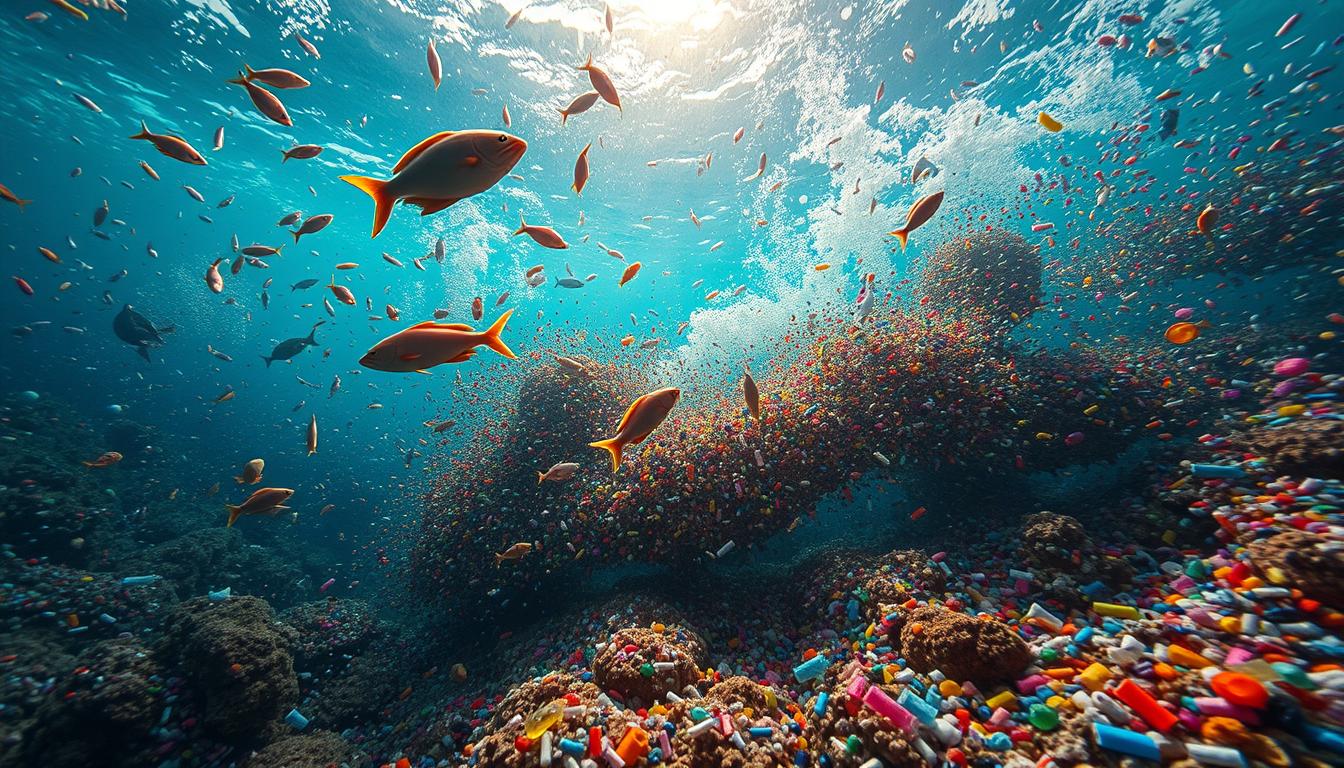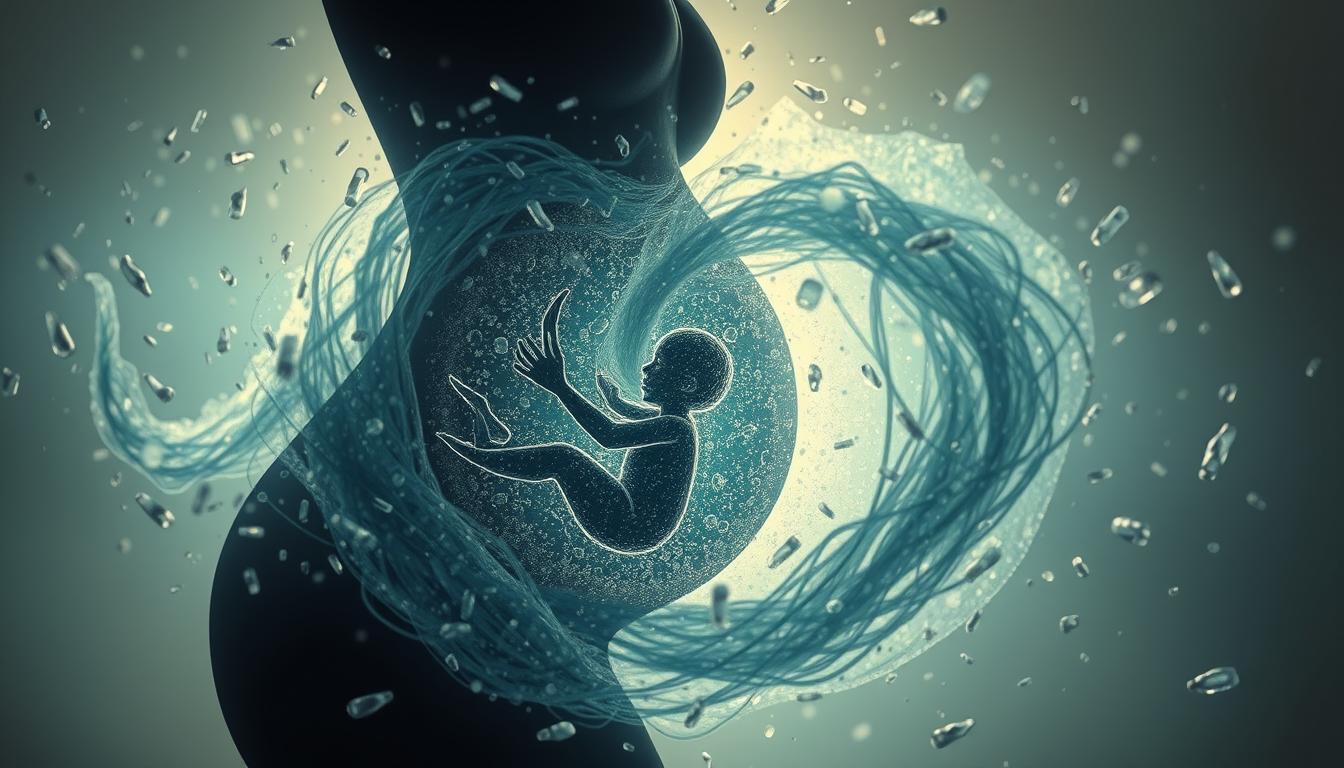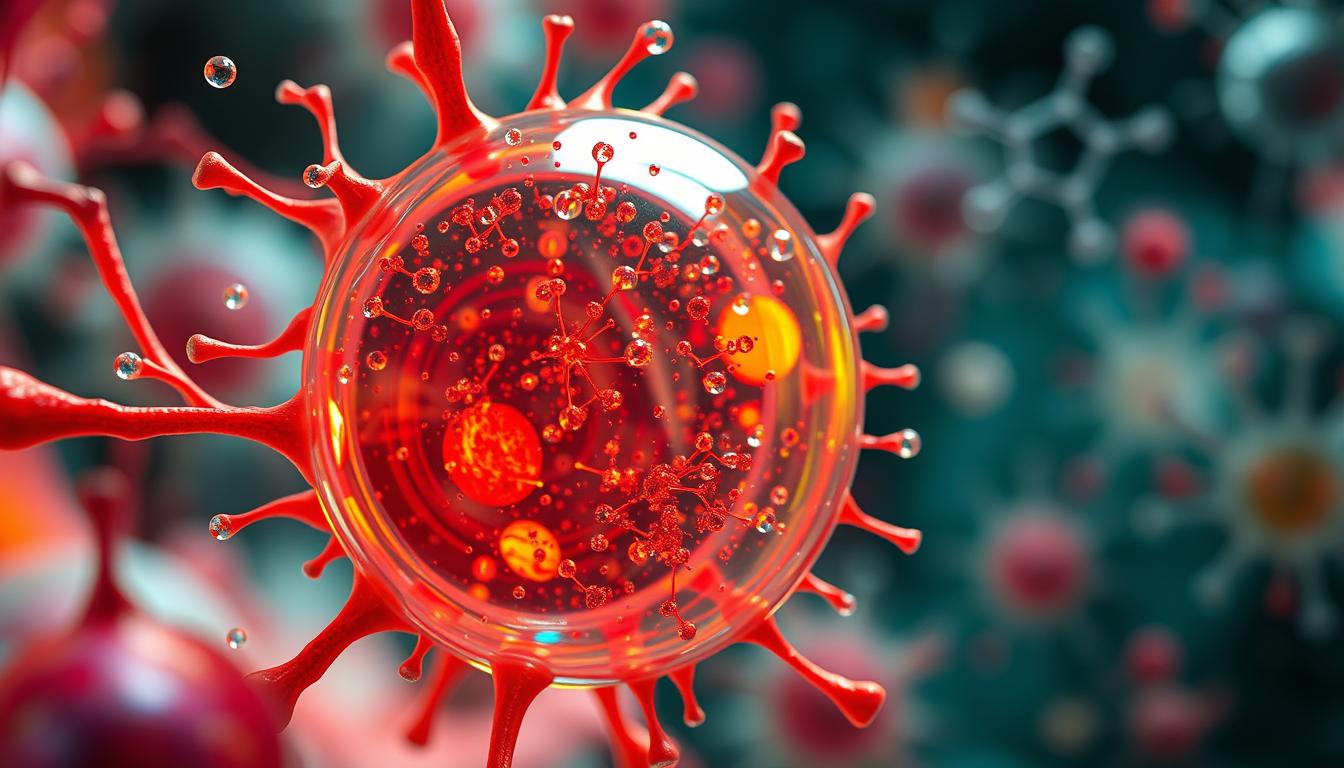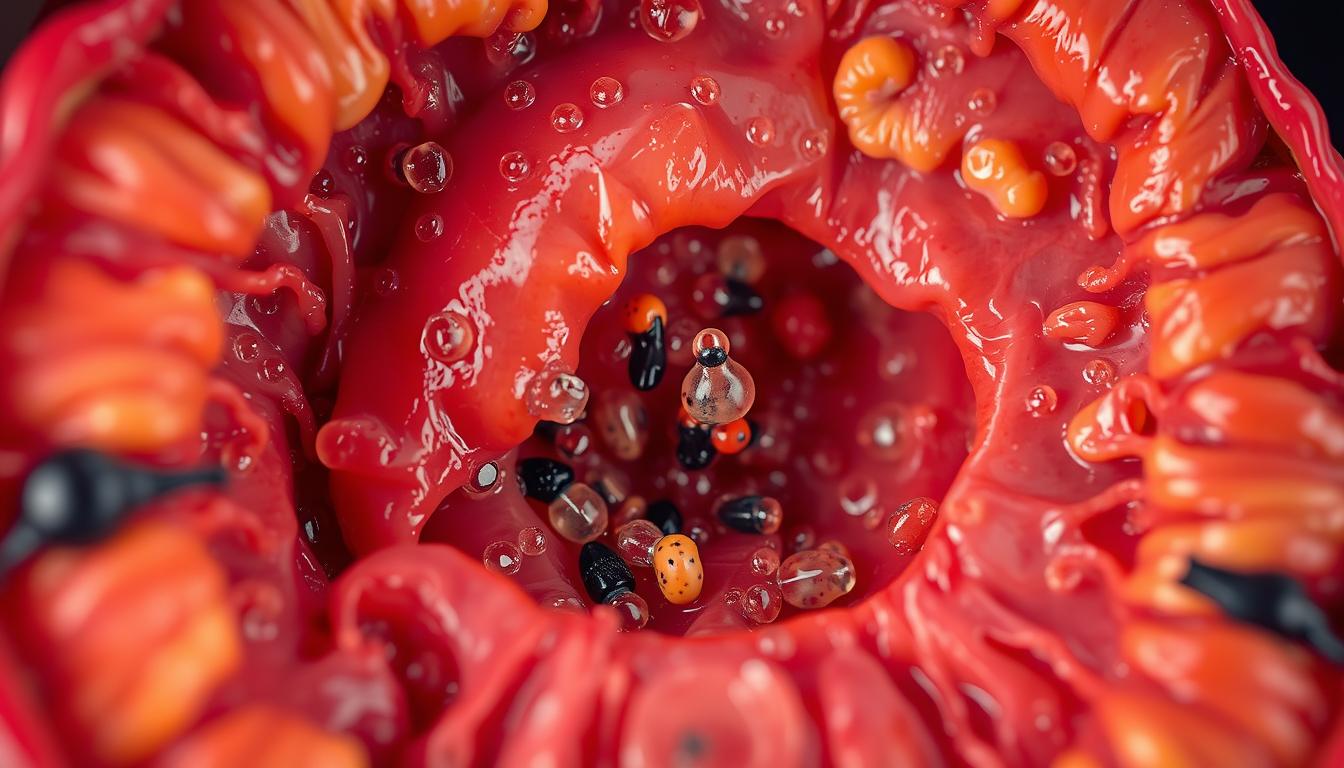Understanding the impact of plastic pollution on health is key. It’s important to know how plastic particles affect reproduction. Studies suggest that microplastics can harm human reproduction, similar to animal studies1. The Bye Microplastics AI app can help you reduce plastic exposure.
It’s vital to grasp the dangers of plastic particles. They are found in human samples like hands and hair1. This affects both male and female fertility. Knowing this helps us understand the problem’s scale and how to avoid it.
Plastic pollution is widespread, affecting many species and environments. Learning about plastic’s reproductive effects helps us make better choices. By taking action, we can protect our health and the environment.
Understanding Plastic Particles and Their Sources
Exploring plastic particles is key to grasping their environmental impact. The effects of microplastics on fertility and reproduction are alarming. Plastic production has skyrocketed, from 1.5 million tonnes to 359.0 million tonnes in 70 years. It’s expected to hit 500.0 million tonnes by 20252.
Plastic particles come from broken-down items, microbeads, and synthetic fibers. They can enter our bodies through eating, breathing, and skin contact. Ingestion is the main way we’re exposed3. Studies show they can harm brain cells and pollute water ecosystems2.
Common plastics include polyethylene, polypropylene, and polystyrene. They’re found in oceans, rivers, and on land4. Here’s a quick look at where they come from and how they affect us:
| Source | Effect |
|---|---|
| Breakdown of larger plastic items | Environmental pollution |
| Microbeads in personal care products | Human exposure through ingestion and dermal contact |
| Synthetic fibers from clothing | Accumulation of toxic pollutants in aquatic ecosystems |
Knowing where plastic particles come from and how they affect us is vital. By cutting down on plastic and recycling more, we can reduce waste. This helps protect our environment and health from plastic’s harmful effects2.
The Science Behind Reproductive Toxicity
Reproductive toxicity is when substances harm the reproductive system. This can cause problems like lower fertility, birth defects, and developmental issues. It’s key to understand how substances affect us to find ways to protect reproductive health.
Studies show that plastic particles can harm reproductive health5. This is a big worry because plastic can mess with hormone balances, damage organs, and change genes6. For instance, microplastics and nanoplastics can soak up harmful pollutants, making things worse6.
The harm from plastic on reproductive health is serious. It can lead to lower survival rates, smaller bodies, and more inflammation and stress6.
What is Reproductive Toxicity?
Reproductive toxicity is a big deal because it can affect fertility and overall health for a long time. It messes with hormone balances, damages organs, and changes genes5. Knowing how this works helps us find ways to protect reproductive health from plastic harm.
Mechanisms of Impact on Reproduction
The ways plastic affects reproduction are complex. It can mess with hormone balances, damage organs, and change genes, leading to harm5. The harm from plastic on reproductive health is severe, causing lower fertility, birth defects, and developmental issues6. It’s vital to understand these effects to find ways to reduce the risks of plastic on fertility.

Health Risks Associated with Plastic Particles
Plastic particles can harm our health, including our reproductive systems. They can cause reproductive toxicity7. Studies show that microplastics may lower sperm quality and quantity in men, affecting fertility1.
In women, microplastics might lead to irregular periods, PCOS, and miscarriages3. The exact ways microplastics harm us are not fully known. But, they might cause inflammation and oxidative stress in our bodies7.
Some possible effects of plastic on reproductive health include:
- Reduced fertility in males
- Irregular menstrual cycles and PCOS in females
- Miscarriages and other pregnancy complications
- Inflammation and oxidative stress in the reproductive system
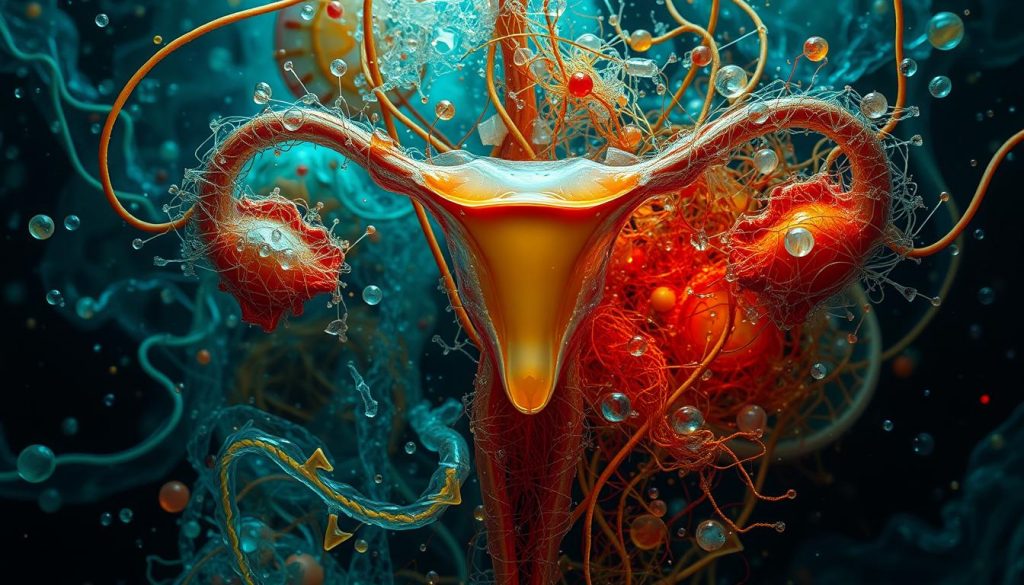
We need to know the dangers of plastic particles and try to avoid them. We can do this by using less plastic, choosing different products, and supporting laws against plastic pollution1. By acting now, we can protect our reproductive health and lower the risks from plastic3.
| Health Risk | Associated with Plastic Particles |
|---|---|
| Reduced fertility | Microplastics and nanoplastics7 |
| Irregular menstrual cycles | Microplastics and plastic additives1 |
| Miscarriages | Plastic particle-induced reproductive toxicity3 |
Specific Plastics Linked to Reproductive Hazards
Exploring plastics and their effects on reproductive health is key. We must focus on plastics that harm reproduction. Microplastics and reproductive toxicity are closely tied, with plastic contamination affecting fertility8. Studies show microplastics can cause harm, including to reproductive and developmental health9.
Bisphenol A (BPA), Phthalates, and other plastics are linked to reproductive hazards. BPA, found in many plastics, disrupts hormones and affects reproductive health. Phthalates, in PVC and personal care items, can cause birth defects and infertility9.
Emerging Plastic Compounds
PFAS, or polyfluoroalkyl substances, are also being studied for reproductive harm. They build up in aquatic species’ reproductive tissues, causing dysfunction9. Microplastics are a growing concern for reproductive health. They can lower sperm quality and fertility in both men and women8.
Understanding microplastics’ risks to reproductive health is vital. We must reduce plastic use and raise awareness. This way, we can strive for a healthier future8.
Research Findings on Plastics and Reproductive Health
Research has shown that plastic pollution affects reproduction a lot. It’s a big concern, with studies focusing on how microplastics impact reproduction10. Microplastics can get into human reproductive organs. They’ve been found in placenta tissue, infant feces, and breast milk10.
Studies found that microplastics can lower the number of eggs in women. They also found a link between microplastics and lower fertility in women. This shows that microplastics can harm reproductive organs10.
Microplastics can disrupt the blood-testis barrier. They can also lower testosterone, LH, and FSH levels. This is due to exposure to nanoparticles10. Microplastics are found in many places, like sewage, soil, oceans, seafood, drinking water, and table salts11.
Research shows that plastic pollution is getting worse. Microplastics are found more often in the environment and in human bodies10. We need more research and action to stop these effects, as the third web source points out.
| Effect of Microplastics | Research Finding |
|---|---|
| Reduction in Ovarian Reserve Capacity | Decrease in ovarian follicles10 |
| Disruption of Blood-Testis Barrier | Dose-dependent decrease in testosterone, LH, and FSH levels10 |
| Presence in Ecosystems | Found in sewage, soil, oceans, seafood, drinking water, and table salts11 |
Regulatory Approaches to Plastic Safety
Understanding the rules on plastic safety is key to protecting your health. The harm plastic particles can cause to fertility is a big worry. In the U.S., laws try to cut down pollution from plastics12. But, more action is needed to tackle the problem fully.
Worldwide, efforts are underway to set global plastic standards. The talks for a global plastics treaty aim to control plastic use and waste. This is vital to lessen the harm of plastic on fertility. Some countries have banned microplastics in certain items, showing it’s doable and cheap to switch to safer options13.
- Implementing extended producer responsibility to encourage sustainable plastic production and disposal practices
- Establishing standards for plastic recycling and proper waste management
- Restricting the use of hazardous chemicals in plastic production
Knowing about these rules helps you deal with plastic safety better. It lets you make choices to lower your exposure to plastic and its impact on your fertility12.
Steps You Can Take to Reduce Risk
Plastic particles can harm reproductive health, but there are ways to lessen the risk14. Eating more plant-based foods, grains, fruits, and vegetables is a good start14. These foods tend to have fewer harmful chemicals than animal products14.
Also, don’t microwave food in plastic containers. The heat can release harmful chemicals15. The Environmental Protection Agency’s Safer Choice program helps pick safer cleaning products15. Using a HEPA filter in your vacuum can also help control dust, which might contain microplastics15.
Your actions can help push for policy changes to fight plastic pollution16. Supporting bans on single-use plastics is a step towards a better future16. The Bye Microplastics AI mobile app can guide you in making better choices about plastic use.
FAQ
What are the common types of plastic particles?
How do plastic particles enter the environment?
What are the human exposure pathways to plastic particles?
What is reproductive toxicity, and how can plastic particles impact it?
How can plastic particles affect male fertility?
How can plastic particles affect female reproductive health?
What specific plastics are linked to reproductive hazards?
What are the key findings from research on plastics and reproductive health?
What are the current regulations on plastic safety in the U.S. and internationally?
What can individuals do to reduce their risk of exposure to plastic particles and mitigate reproductive health impacts?
Source Links
- Toxicity of microplastics and nanoplastics: invisible killers of female fertility and offspring health
- Microplastic sources, formation, toxicity and remediation: a review – Environmental Chemistry Letters
- Health Effects of Microplastic Exposures: Current Issues and Perspectives in South Korea
- Research recommendations to better understand the potential health impacts of microplastics to humans and aquatic ecosystems – Microplastics and Nanoplastics
- Chronic exposure to polystyrene microplastics induced male reproductive toxicity and decreased testosterone levels via the LH-mediated LHR/cAMP/PKA/StAR pathway – Particle and Fibre Toxicology
- Microplastics and Their Impact on Reproduction—Can we Learn From the C. elegans Model?
- Plastic and Human Health: A Lifecycle Approach to Plastic Pollution – Center for International Environmental Law
- Microplastics exposure: implications for human fertility, pregnancy and child health
- Frontiers | Developmental and reproductive toxic effects of exposure to microplastics: A review of associated signaling pathways
- Concerning influences of micro/nano plastics on female reproductive health: focusing on cellular and molecular pathways from animal models to human studies – Reproductive Biology and Endocrinology
- Frontiers | Microplastics and Their Impact on Reproduction—Can we Learn From the C. elegans Model?
- A Detailed Review Study on Potential Effects of Microplastics and Additives of Concern on Human Health
- Microplastic regulation should be more precise to incentivize both innovation and environmental safety – Nature Communications
- Plastics and Human Health | Plastics and the Environment Series
- I’m a Microplastics Researcher. Here’s How To Limit Their Dangers
- How to Eat Less Plastic – Consumer Reports

